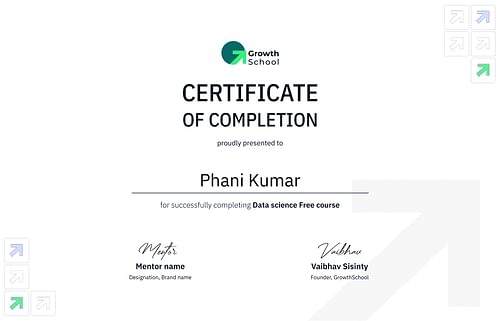Free Online Design Course to Learn the Art of Creating Design Systems and its Implementation
Learn the Art of Creating Design Systems and Implementation. Join our Free Online Design Course!
Before you ask, we do give certificates!
Get certified upon course completion and supercharge your career journey.

Learning Objectives
1. Emphasizing Efficiency in Design Systems
Implementing a foundational layer of typography, color, and spacing to influence design components like atoms and molecules.
2. Strategic Design Work Before Development
Stressing the importance of completing design work prior to development, allowing for effective design and testing within well-structured timelines.
3. Tailoring Design Systems to Project Objectives
In the project incubation phase, the design system team's role is crucial in understanding target audience and project goals to tailor design components accordingly.
4. Overcoming Design Challenges Through Creativity
Encouraging designers to think beyond user story constraints and introduce separate design enhancement stories to tackle communication and governance complexities effectively.
Read More
Who's it for
Designers
Design Managers
UX/UI Professionals
Product Managers
Front-end Developers
Our Learners love GrowthSchool
What will I learn
Chapter 1
Introduction to Design System in Agile
This chapter introduces the importance of design systems in Agile methodologies, emphasizing the need for consistent communication through audio and video settings in chat platforms. It discusses the structure of the design system team, readiness stages, impacts on designers, and the transition from theoretical concepts to practical use cases.
Chapter 2
Foundation of Design Systems
The focus of this chapter is on the foundational elements of a design system, such as typography, color, and spacing, and how they contribute to the creation of components like atoms and molecules. The chapter highlights the significance of completing design work before development to ensure thorough testing and consistency across platforms.
Chapter 3
Project Incubation Phase
In this chapter, the role of the design system team during the project incubation phase is explored. Emphasis is placed on understanding the target audience, project objectives, and design language to create a better user experience tailored to specific audiences like Gen Z. The chapter delves into the importance of consistency, scalability, and efficiency in design processes.
Chapter 4
Designers' Challenges and Creativity
The challenges faced by designers in communication and dependencies are discussed in this chapter. Designers are encouraged to think creatively beyond user stories to develop innovative solutions and address governance issues as dependencies grow. The chapter also recommends separate design enhancement stories for additional options and experiences.
Chapter 5
Transitioning to New Design Systems
This chapter focuses on the transition from old to new design systems in light of business requirements. It suggests selecting components from old screens for updating new ones, engaging in reverse engineering if necessary to ensure alignment with the overall design system and brand continuity. Suggestions are provided for a smoother conversion process.
Chapter 6
Setting Up a Design System
A designer seeking advice on setting up a design system is the focal point of this chapter. The importance of pausing UI work to prioritize the development of a design system is highlighted, particularly for designers with extensive high-fidelity and hyperlink files. Recommendations are given on getting started with the Carbon design system.
Chapter 7
Enhancing Design Processes
This chapter discusses the need for designers to assert the importance of lead time for design work to avoid working within the same sprint as developers. It emphasizes the value of thorough design processes and proper testing through separate design enhancement stories for additional options and experiences, especially for ad hoc changes from the business.
Chapter 8
Governance and Maintenance of Design Systems
In this final chapter, the governance and maintenance of design systems are explored, focusing on the management of dependencies as the design system evolves. Designers are advised to maintain alignment with project goals and consider creative solutions beyond existing constraints. Proper consideration and testing of enhancements before implementation are essential for successful design system governance.
Chapter 9
Design Principles and App Look
The core content discusses how design principles influence the look of an app, highlighting considerations such as color, typography, border radius, and motion. By understanding these elements, participants can enhance the visual appeal and user experience of their design systems.
Chapter 10
Developing Efficient Design Systems
This chapter delves into how implementing various design components can help in developing a design system efficiently. It explores the importance of consistency and coherence in design choices to create a cohesive and user-friendly experience across different platforms and devices.
Chapter 11
Copy, Voice, and Tone Guidelines
Guidelines for copy, voice, and tone are discussed in this chapter as essential elements of a comprehensive design system. Participants learn how to align messaging with the overall design aesthetic to maintain brand identity and enhance user engagement.
Chapter 12
Revamping Outdated Design Systems
Participants are guided on the process of designing in a new design system, with opportunities to revamp screens if using an outdated system. The chapter explores strategies for transitioning the entire product to the new design system while ensuring a seamless user experience.
Chapter 13
Adhering to Design Systems
Reasons why a designer may not adhere to a design system are explored in this chapter, shedding light on potential challenges such as limitations on creative freedom. Participants learn how to balance creative expression with the need for consistency and efficiency in design implementations.
Meet your Mentor
Chinmay Krishna
Founder @ Koalahire
Chinmay Krishna is the innovative Founder of Koalahire, based in Bengaluru, Karnataka. With a passion for design and talent acquisition, he also serves as the Co-Founder of Design hiring co-pilot. Dedicated to revolutionizing recruitment practices, he brings a wealth of experience and expertise to the industry.
Frequently Asked Questions
What are the main pillars of free online design course?
The main pillars include design principles, software proficiency, project execution, and creative problem-solving techniques.
What is free online design course, and why is it important to learn about?
Free online design courses offer instruction on design fundamentals, tools, and techniques crucial for professional growth.
Is these free online design course course designed for corporate training and workforce upskilling?
Yes, these courses are suitable for corporate training and upskilling employees in design principles and techniques.
How long can I access the Designing content?
You can typically access the design content for a specific duration, usually ranging from weeks to months.
Will I receive a certification upon completion of the Designing course?
Yes, most free online design courses offer certificates to acknowledge completion and proficiency in design principles.

Learn the Art of Creating Design Systems and its Implementation
4.2
(315 ratings)
Beginner
15 May 2025 at 6:30 am GMT
23k Learners enrolled
Mentor
Chinmay Krishna
Founder @ Koalahire
Why GrowthSchool?
GrowthSchool is where you become the Top 1% in your field. We bring the best of Product, Growth, Design, Tech, data and business mentors from brands like Google, Meta, Uber etc doing the jobs you want to do tomorrow.
400k+
Total Students
Top Startup India 2024
Backed by the best
and 80+ Angel investors like



What are Free Courses?
Free online courses offer a wealth of knowledge in product, design, growth, and marketing without cost. They provide flexibility for skill enhancement and professional development. Many courses include certificates, bolstering resumes and LinkedIn profiles, demonstrating a commitment to learning and advancement in these dynamic fields.




